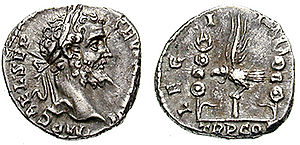
Legio I Italica
Encyclopedia

Roman legion
A Roman legion normally indicates the basic ancient Roman army unit recruited specifically from Roman citizens. The organization of legions varied greatly over time but they were typically composed of perhaps 5,000 soldiers, divided into maniples and later into "cohorts"...
levied by emperor Nero
Nero
Nero , was Roman Emperor from 54 to 68, and the last in the Julio-Claudian dynasty. Nero was adopted by his great-uncle Claudius to become his heir and successor, and succeeded to the throne in 54 following Claudius' death....
on September 22, 66 (the date is attested by an inscription). There are still records of the I Italica in the Danube
Danube
The Danube is a river in the Central Europe and the Europe's second longest river after the Volga. It is classified as an international waterway....
border in the beginning of the 5th century. The emblem of the legion was a boar
Boar
Wild boar, also wild pig, is a species of the pig genus Sus, part of the biological family Suidae. The species includes many subspecies. It is the wild ancestor of the domestic pig, an animal with which it freely hybridises...
.
History
In the aftermath of the Roman–Parthian War of 58–63, Emperor Nero levied the I Italica with the name phalanx Alexandri Magni ("phalanxPhalanx formation
The phalanx is a rectangular mass military formation, usually composed entirely of heavy infantry armed with spears, pikes, sarissas, or similar weapons...
of Alexander the Great"), for a campaign in Armenia
Armenia
Armenia , officially the Republic of Armenia , is a landlocked mountainous country in the Caucasus region of Eurasia...
, ad portas Caspias - to the pass of Chawar. The sources mention the peculiar fact that the original legionaries
Legionary
The Roman legionary was a professional soldier of the Roman army after the Marian reforms of 107 BC. Legionaries had to be Roman citizens under the age of 45. They enlisted in a legion for twenty-five years of service, a change from the early practice of enlisting only for a campaign...
were Italics
Italia (Roman province)
Italia was the name of the Italian peninsula of the Roman Empire.-Under the Republic and Augustan organization:During the Republic and the first centuries of the empire, Italia was not a province, but rather the territory of the city of Rome, thus having a special status: for example, military...
, all over six feet tall. However, since the Jewish Revolt broke out a few weeks later, the projected Armenian campaign never took place. Also, the governor of Gaul
Roman Gaul
Roman Gaul consisted of an area of provincial rule in the Roman Empire, in modern day France, Belgium, Luxembourg, and western Germany. Roman control of the area lasted for less than 500 years....
, Gaius Julius Vindex, rose in revolt in early 68 and I Italica was redirected there, arriving just in time to see the end of the revolt. In the Year of the Four Emperors
Year of the Four Emperors
The Year of the Four Emperors was a year in the history of the Roman Empire, AD 69, in which four emperors ruled in a remarkable succession. These four emperors were Galba, Otho, Vitellius, and Vespasian....
(69), after the death of Nero, the legion received the name I Italica and fought for Vitellius
Vitellius
Vitellius , was Roman Emperor for eight months, from 16 April to 22 December 69. Vitellius was acclaimed Emperor following the quick succession of the previous emperors Galba and Otho, in a year of civil war known as the Year of the Four Emperors...
at the second Battle of Bedriacum
Battle of Bedriacum
The Battle of Bedriacum refers to two battles fought during the Year of the Four Emperors near the village of Bedriacum , about from the town of Cremona in northern Italy...
, where the Vitellians were defeated by forces supporting Vespasian
Vespasian
Vespasian , was Roman Emperor from 69 AD to 79 AD. Vespasian was the founder of the Flavian dynasty, which ruled the Empire for a quarter century. Vespasian was descended from a family of equestrians, who rose into the senatorial rank under the Emperors of the Julio-Claudian dynasty...
. The new emperor sent I Italica to the province of Moesia
Moesia
Moesia was an ancient region and later Roman province situated in the Balkans, along the south bank of the Danube River. It included territories of modern-day Southern Serbia , Northern Republic of Macedonia, Northern Bulgaria, Romanian Dobrudja, Southern Moldova, and Budjak .-History:In ancient...
in 70. They encamped at Novae
Novae
Archaeological site situated on the Danube in northern Bulgaria, about 4 kilometres east of the modern town Svishtov. A legionary base and late Roman town in the Roman province Moesia Inferior, later Moesia II.-Localisation and topography:...
(modern Svishtov
Svishtov
Svishtov is a town in northern Bulgaria, located in Veliko Tarnovo Province on the right bank of the Danube river opposite the Romanian town of Zimnicea. It is the administrative centre of the homonymous Svishtov Municipality...
) and remained there for centuries.
During the Dacian wars of Trajan
Trajan
Trajan , was Roman Emperor from 98 to 117 AD. Born into a non-patrician family in the province of Hispania Baetica, in Spain Trajan rose to prominence during the reign of emperor Domitian. Serving as a legatus legionis in Hispania Tarraconensis, in Spain, in 89 Trajan supported the emperor against...
, the legion was responsible for bridge construction at the Danube
Danube
The Danube is a river in the Central Europe and the Europe's second longest river after the Volga. It is classified as an international waterway....
. Building activities seem to have been an area of expertise for the legion. Around 140, a centurion
Centurion
A centurion was a professional officer of the Roman army .Centurion may also refer to:-Military:* Centurion tank, British battle tank* HMS Centurion, name of several ships and a shore base of the British Royal Navy...
from I Italica was responsible for the construction of a section of the Antonine Wall
Antonine Wall
The Antonine Wall is a stone and turf fortification built by the Romans across what is now the Central Belt of Scotland, between the Firth of Forth and the Firth of Clyde. Representing the northernmost frontier barrier of the Roman Empire, it spanned approximately 39 miles and was about ten feet ...
.
During the reign of Marcus Aurelius, I Italica was almost certainly involved in the wars against the Germanic tribes
Marcomannic Wars
The Marcomannic Wars were a series of wars lasting over a dozen years from about AD 166 until 180. These wars pitted the Roman Empire against the Marcomanni, Quadi and other Germanic peoples, along both sides of the upper and middle Danube...
that threatened to cross the Danube. After a long war, the Romans had conquered much territory on the left side of the Danube. There Marcus Aurelius had intended to form a new province under governor Aulus Julius Pompilius Piso, commander of I Italica and IV Flavia Felix
Legio IV Flavia Felix
Legio quarta Flavia Felix , was a Roman legion levied by Vespasian in 70, from the ashes of the Legio IV Macedonica. The legion was active in Moesia Superior in the first half of the 4th century...
, but the revolt of Avidius Cassius
Avidius Cassius
Gaius Avidius Cassius was a Roman general and usurper who briefly ruled Egypt and Syria in 175.-Origins:He was the son of Gaius Avidius Heliodorus, a noted orator who was Prefect of Egypt from 137 to 142 under Hadrian, and wife Junia Cassia Alexandra...
in the East prevented the formation of the new province.
In 193, the Governor of Pannonia Superior, Septimus Severus claimed the purple and moved to Italia
Italia (Roman province)
Italia was the name of the Italian peninsula of the Roman Empire.-Under the Republic and Augustan organization:During the Republic and the first centuries of the empire, Italia was not a province, but rather the territory of the city of Rome, thus having a special status: for example, military...
. I Italica supported Severus, but did not move to Italy. The legion fought against Severus' rival, Pescennius Niger
Pescennius Niger
Pescennius Niger was a Roman usurper from 193 to 194 during the Year of the Five Emperors. He claimed the imperial throne in response to the murder of Pertinax and the elevation of Didius Julianus, but was defeated by a rival claimant, Septimius Severus and killed while attempting to flee from...
, besieging Byzantium together with XI Claudia
Legio XI Claudia
Legio undecima Claudia was a Roman legion. XI Claudia dates back to the two legions recruited by Julius Caesar to invade Gallia in 58 BC, and it existed at least until early 5th century, guarding lower Danube in Durostorum...
, fighting at Issus. The First possibly took part in the Parthia
Parthia
Parthia is a region of north-eastern Iran, best known for having been the political and cultural base of the Arsacid dynasty, rulers of the Parthian Empire....
n campaign of Severus (198).
In the 3rd century , during the rule of Caracalla
Caracalla
Caracalla , was Roman emperor from 198 to 217. The eldest son of Septimius Severus, he ruled jointly with his younger brother Geta until he murdered the latter in 211...
, the legion took part in the construction of the Limes Transalutanus
Limes Transalutanus
Limes Transalutanus is a fortified frontier system of the Roman Empire, built on the western edge of Teleorman's forests. The frontier was composed by a road following the border, military stonghold, a three metre vallum 10–12 metres wide, reinforced with wood palisades on stone walls, and also a...
, a defensive wall along the Danube, which began near Novae. Under Alexander Severus
Alexander Severus
Severus Alexander was Roman Emperor from 222 to 235. Alexander was the last emperor of the Severan dynasty. He succeeded his cousin Elagabalus upon the latter's assassination in 222, and was ultimately assassinated himself, marking the epoch event for the Crisis of the Third Century — nearly fifty...
, some vexillatio
Vexillatio
A vexillatio was a detachment of a Roman legion formed as a temporary task force created by the Roman Army of the Principate. It was named from the standards carried by legionary detachments, vexillum , which bore the emblem and name of the parent legion...
nes of the I Italica moved to Salonae, guarding the Dalmatian coast.
See also
- List of Roman legions
- CapidavaCapidavaCapidava is a South American spider genus of the Salticidae family .-Species:* Capidava annulipes Caporiacco, 1947 — Guyana* Capidava auriculata Simon, 1902 — Brazil* Capidava biuncata Simon, 1902 — Brazil...

